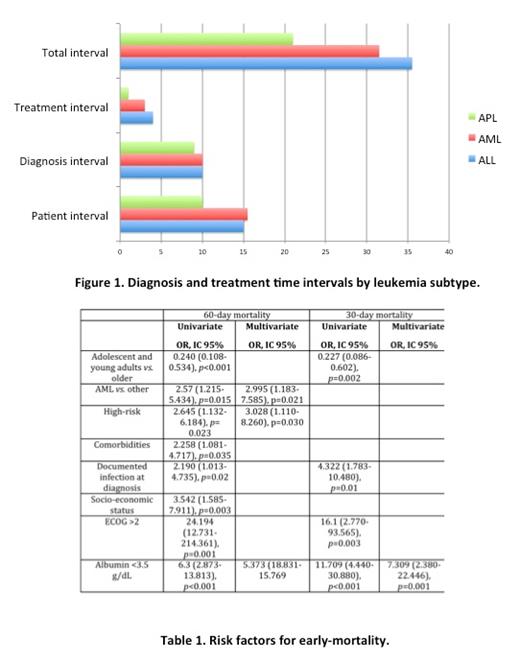Abstract
Introduction:
Mexico, like other Middle-Income Countries (MIC), faces many challenges in the care of patients with cancer. The number of practicing physicians is lower than the recommended for the OECD, there is <1 hematologist/100,000 people, and the attention is centralized in big cities .
It has been reported that children with acute lymphoblastic leukemia (ALL) suffer from significant diagnosis delays in Latin America but this has not been assessed in adults.
There is a well-described association between delays in diagnosis and poor outcomes in some solid tumors. Acute leukemia (AL) is associated with a shorter time-to-diagnosis when compared with other malignancies. However, its impact on early death (ED) or long-term outcomes is not clear.
Methods:
We designed a retrospective single center study with the main objective of analyzing the diagnosis and treatment delays in adults with newly diagnosed AL in a referral center in Mexico City.
We defined the following intervals. Patient interval (PI): from the first symptom to the first medical consultation. Diagnostic interval (DI): from the first medical consultation to the diagnosis. Treatment interval (TI): from the diagnosis to the treatment initiation. Total interval (TTI): from the first symptom to the treatment initiation.
We evaluated patients ≥18 years diagnosed with ALL, acute myeloid leukemia (AML) or acute promyelocytic leukemia (APL) between January 2015-March 2020.
Results:
We included 187 patients with a median age of 36 years (18-90), the majority adolescent and young adults (AYA) (54.4%): 102 ALL, 56 AML and 29 APL.
Almost half of them (43.4%) lived in Mexico City, only 20.3% had a professional degree and 80.2% had a low socioeconomic status (LSE).
The majority (85.5%) received intensive chemotherapy, 6.7% a non-intensive regimen and 7.8% supportive care.
The patients consulted a median of 3 different physicians (range 1-9) before the hematologist. The median interval times were: PI 14 days (0-182), DI 10 days (0-221), TI 4 days (0-22) and TTI 32 days (3-252).
The TI and TTI were significantly shorter in patients with APL when compared with ALL and AML: TI of 1 vs. 4 and 3 days (p=0.001) and TTI of 21 vs. 35 and 31 days (p=0.002). The PI and DI were not different between AL subtypes (figure 1).
Patients with comorbidities had a significant shorter DI: 9 (0-65) vs. 11 days (0-221), p=0.045. Patients living in Mexico City had a significant shorter DI: 7 (0-221) vs. 11.5 days (0-148), p=0.015; and TTI: 28 (3-252) vs. 34 days (3-183), p= 0.030.
A DI > 3 weeks was associated with a higher risk of neutropenic colitis (15.9% vs. 6.0%): OR 2.94 (CI 1.03-8.43), p= 0.057.
The 30-day and 60-day mortality were 12.8% and 19.3%, mainly derived from infectious complications in 58.3% and 69.4%. Risks factors for ED are summarized in table 1.
Twenty patients had a TTI ≥ 85 days: 60% were AYA, the majority ALL (ALL 11, AML 7 and APL 2), with LSE (89.5%) and living outside Mexico City (70%). The 30-day and 60-day mortality were 15% and 25% for this group.
None of the intervals was associated with a higher-risk of ED with the exception of longer TI for patients with APL who died within 60 days (2.5 vs. 1 day, p=0.024). None of the intervals was associated with complete remission probability or long-term overall survival.
Conclusions:
To our knowledge, this is the first insight into the delays in adults with AL in a MIC. Surprisingly, the median intervals are not different when compared with high-income countries (HIC). However, the upper limit of the ranges is significantly higher in Mexico than in the UK registry (TTI in Mexico for ALL and AML are 221 and 252 days vs. 64 and 85 days in the UK). In our study, delays do not impact in short or long-term outcomes. But we believe that there may be a significant number of patients with more aggressive disease, who died before diagnosis. ED is still high in Mexico and the leading cause is infections.
Patients from Mexico City had shorter diagnostic intervals when compared to patients living outside the city. This could be related with structural barriers of the health system that make timely cancer care inaccessible. Patient navigation is a promising intervention to address cancer disparities that allows reducing times. Most of the patient navigation models are focus on solid tumors, in screening and palliative care and in HIC. In our population, with a high frequency of ALL and APL in AYAs with a good chance of cure, a patient navigation model needs to be adapted.
Apodaca: Abbvie: Speakers Bureau; Asofarma: Consultancy, Speakers Bureau; Sanofi: Consultancy. Rangel-Patiño: Bristol: Consultancy; Abbvie: Speakers Bureau. Demichelis: ASH: Research Funding; Gilead: Consultancy; Bristol/Celgene: Consultancy, Speakers Bureau; Jazz: Consultancy; Novartis: Consultancy, Research Funding, Speakers Bureau; AMGEN: Consultancy, Speakers Bureau; Astellas: Consultancy; Abbvie: Consultancy, Speakers Bureau.


This feature is available to Subscribers Only
Sign In or Create an Account Close Modal